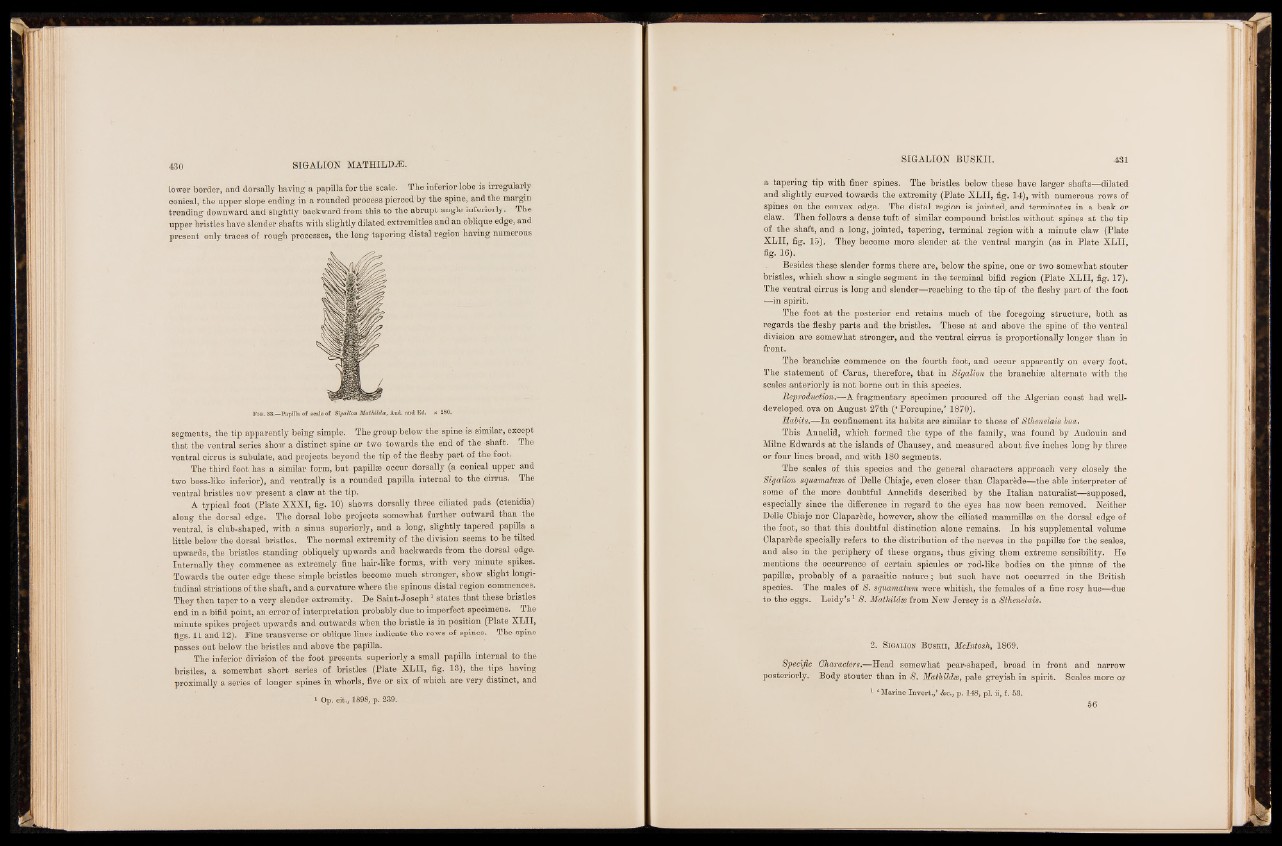
430 SIGALION MATHILDAS.
lower border, and dorsally having a papilla for the scale. The inferior lobe is irregularly
conical, the upper slope ending in a rounded process pierced by the spine, and the margin
trending downward and slightly backward from this to the abrupt angle interiorly. The
upper bristles have slender shafts with slightly dilated extremities and an oblique edge, and
present only traces of rough processes, the long tapering distal region having numerous
Fig . 33.—Papilla of scale of Sigalion M athilda, And. and Ed. x 280.
segments, the tip apparently being simple. The group below the^spine is similar, except
that the ventral series show a distinct spine or two towards the end of the shaft. The
ventral cirrus is subulate, and projects beyond the tip of the fleshy part of the foot..
The third foot has a similar form, but papillas occur dorsally (a conical upper and
two boss-like inferior), and ventrally is a rounded papilla internal to the cirrus. The
ventral bristles now present a claw at the tip.
A typical foot (Plate XXXI, fig. 10) shows dorsally three ciliated pads (ctenidia)
along the dorsal edge. The dorsal lobe projects somewhat further outward than the
ventral, is club-shaped, with a sinus superiorly, and a long, slightly tapered papilla a
little below the dorsal bristles. The normal extremity of the division seems to be tilted
upwards, the bristles standing obliquely upwards and backwards from the dorsal edge.
Internally they commence as extremely fine hair-like forms, with very minute spikes.
Towards the outer edge these simple bristles become much stronger, show slight longitudinal
striations of the shaft, and a curvature where the spinous distal region commences.
They then taper to a very slender extremity. De Saint-Joseph1 states that these bristles
end in a bifid point, an error of interpretation probably due to imperfect specimens. The
minute spikes project upwards and outwards when the bristle is in position (Plate XLII,
figs. 11 and 12). Pine transverse or oblique lines indicate the rows of spines. The spine
passes out below the bristles and above the papilla.
The inferior division of the foot presents superiorly a small papilla internal to the
bristles, a somewhat short series of bristles (Plate XLII, fig. 13), the tips having
proximally a series of longer spines in whorls, five or six of which are very distinct, and
' 1 Op. cit., 1898, p. 239.
a tapering tip with finer spines. The bristles below these have larger shafts—dilated
and slightly curved towards the extremity (Plate XLII, fig. 14), with numerous rows of
spines on the convex edge. The distal region is jointed, and terminates in a beak or
claw. Then follows a dense tuft of similar compound bristles without spines at the tip
of the shaft, and a long, jointed, tapering, terminal region with a minute claw (Plate
XLII, fig. 15). They become more slender at the ventral margin (as in Plate XLII,
fig. 16),
Besides these slender forms there are, below the spine, one or two somewhat stouter
bristles, which show a single segment in the terminal bifid region (Plate XLII, fig. 17).
The ventral cirrus is long and slender—reaching to the tip of the fleshy part of the foot
—in spirit.
The foot at the posterior end retains much of the foregoing structure, both as
regards the fleshy parts and the bristles. Those at and above the spine of the ventral
division are somewhat stronger, and the ventral cirrus is proportionally longer than in
front.
The branchiæ commence on the fourth foot, and occur apparently on every foot.
The statement of Carus, therefore, that in Sigalion the branchiæ alternate with the
scales anteriorly is not borne out in this species.
Reproduction:—A fragmentary specimen procured off the Algerian coast had well-
developed ova on August 27th (‘ Porcupine,’ 1870).
Habits.—In confinement its habits are similar to those of Sthenelais boa.
This Annelid, which formed the type of the family, was found by Audouin and
Milne Edwards at the islands of Chausey, and measured about five inches long by three
or four lines broad, and with 180 segments.
The scales of this species and the general characters approach very closely the
Sigalion squamatum of Delle Chiaje, even closer than Claparède—the able interpreter of
some of the more doubtful Annelids described by the Italian naturalist—supposed,
especially since the difference in regard to the eyes has now been removed. Neither
Delle Chiaje nor Claparède, however, show the ciliated mammillæ on the dorsal edge of
the foot, so that this doubtful distinction alone remains. In his supplemental volume
Claparède specially refers to the distribution of the nerves in the papillæ for the scales,
and also in the periphery of these organs, thus giving them extreme sensibility. He
mentions the occurrence of certain spicules or rod-like bodies on the pinnæ of the
papillæ, probably of a parasitic nature ; but such have not occurred in the British
species. The males of S. squamatum were whitish, the females of a fine rosy hue—due
to the eggs. Leidy’s 1 S. Mathildse from New Jersey is a Sthenelais.
2. S igalion B uskii, McIntosh, 1869.
Specific Gha/racters.—Head somewhat pear-shaped, broad in front and narrow
posteriorly. Body stouter than in S. Mathildse, pale greyish in spirit. Scales more or
1 ‘ Marine Invert./ &c., p. 148, pi. ii, f. 53.
56